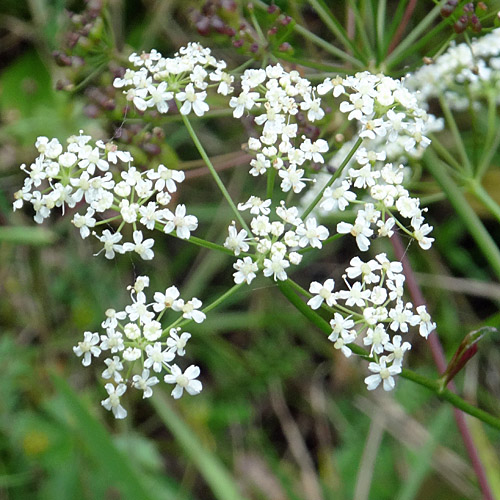 |  |  |  |  |
 |  |  |  |
Burnet-saxifrage
is a perennial plant that reaches up to 60 cm in height. It is characterized by an erect and bare stem, it is hollow, covered with a small down and topped with a beautiful floral shield. The leaves are located on the underside of the stem, they are split, on long stalks, serrated along the edges, there are also solitary oval leaves. The leaves vary in size as they are closer to the soil as they are larger.
The flowers are small, but in large numbers - white or soft pink. Flowers in clusters of 5-12 pieces, bloom from June to November. The seeds ripen from August to December, they are light brown in color. Reproduces only with the help of seeds.
The root of the
Burnet-saxifrage
is medium-sized (up to 2 cm in diameter), spike-shaped. Dark brown in color, reaching a depth of 20 or more centimeters.
In traditional medicine, the root of the
Burnet-saxifrage
is used, which is dug in September-October. Use only large and mature plants with a fully developed root system. The roots are dug up, rinsed in running water and spread out to dry. Dry the root in a shady place spread on sieves. The root of the plant has a spicy-sweet taste and a strong smell. The root of the
Burnet-saxifrage
is stored in a closed container and chopped just before use. The drug can be stored for 3 years.
In order to preserve the stand, 1/5 of the plants should be left after harvesting so that they can multiply again in the new season.
The leaves and stems are collected in May, until the plant begins to flower. It is spread in a shady place on sieves and allowed to dry (in fresh air).
The seeds of
Burnet-saxifrage
are collected in autumn, when they are already fully matured. Ready seeds are light brown in color, to get the seeds, cut off the whole chemer and dry it. When drying the seed pods hanging, it is good to lay a cloth on the bottom on which the seeds will fall. Seeds can be stored for up to 2 years in a dark place, preferably in a clay container.
Furocoumarins, saponins, bitter substances, resins, gums, tannins, sugars, coumarins, vegetable fats and essential oils, benzoic acid and acetic acid have been found in the roots and rhizomes of the plant.
The surface part of the plant contains 32% fiber, 11% protein, 2.6% fat. There is also carotene and vitamin C. The taste is not pronounced, a bit harsh, refreshing and a little astringent, the taste "opens up" gradually.
Medicinal significance
Burnet-saxifrage
is used as an anti-inflammatory agent to treat bronchitis, laryngitis, angina, pneumonia - it is prepared both as a decoction and as an infusion. The plant helps reduce temperature, promotes expectoration, increases sweating, reduces fever and has an astringent effect. An extract of mountain hornbeam alcohol can relieve hoarseness within a few minutes. Fresh juice will help cure a runny nose.
Burnet-saxifrage
helps to get rid of edema and what is great - it helps to prevent the recurrence of edema, it also improves the functioning of the urinary organs. With long-term use of this plant, it acts as a strong diuretic, which helps to remove sand and stones from the kidneys and bladder.
The plant helps with gastritis and constipation, improves the functioning of the digestive tract and increases appetite. Eating its fresh leaves improves intestinal peristalsis and reduces flatulence. This plant also has pain-relieving properties that will help ease the condition of internal ulcers and gout.
Burnet-saxifrage
also has a calming effect. An alcohol extract helps with fatigue, headaches and anxiety. The painkillers present in the plant will have a relaxing effect and improve well-being in case of severe diseases.
Burnet-saxifrage
is used in various herbal tea mixtures, which are used to treat burns, hemorrhoids, and skin tears. Rub into the skin as a pain reliever for various joint pains. In many countries, it is used as an antitumor plant and used in oncology.
As usual,
Burnet-saxifrage
can also cause an allergic reaction. The plant is also not used during pregnancy and lactation, as well as children under 12 years of age. Side effects that may occur if allergic to it: rash, edema, runny nose, difficulty breathing. In case of overdose, photodermatitis appears. When using this plant, you should strictly follow the recommendations for therapeutic doses.
For men
In mixtures, this plant is used to treat prostate adenoma or prostatitis.
